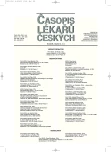Addictive diseases and poverty
Authors:
K. Nešpor; J. Čapková; L. Csémy
Authors‘ workplace:
Psychiatrická léčebna Bohnice, Praha
Published in:
Čas. Lék. čes. 2010; 149: 381-384
Category:
Special Articles
Overview
Poverty is one of the risk factors for substance dependence and pathological gambling. Poverty interacts with other, often more important, protective and risk factors. Healthcare facilities should take into account the social situation of their patients; for example they can provide relevant information about social services or mediate social help. Communication with patient’s family or community is also beneficial. Patients, as part of their treatment, can be instructed how to handle money and debts. On the other hand charitable organizations should take into account addictive problems of their clients.
Key words:
poverty, addiction, pathological gambling, treatment, social work.
Sources
1. Nešpor K, Scheansová A. Návykové nemoci a peníze – důležité souvislosti. Čas Lék čes 2009; 148(7): 335–337.
2. Lawyers and substance abuse. www.thefreelibrary.com/ Lawyers+and+substance+abuse-a063129384. Accessed 15. 6. 2010.
3. Sovinová H, Csémy L. Socio-economic aspects of alcohol consumption and related problems based on current research in the Czech adult population. EPHA Conference Health in the Enlarged EU, Bratislava 16.–17. 4. 2007.
4. Nešpor K, Scheansová A, Karbanová H. Zadluženost lidí s návykovými nemocemi je zdravotní i společenský problém. Čas. Lék čes 2010; 149: 38–40.
5. Robitaille E, Herjean P. An analysis of the accessibility of video lottery terminals: the case of Montréal. Int J Health Geogr 2008; 18(7): 2.
6. Crane M, Byrne K, Fu R, Lipmann B, Mirabelli F, Rota-Bartelink A, Ryan M, Shea R, Watt H, Warnes AM. The causes of homelessness in later life: findings from a 3-nation study. J Gerontol B Psychol Sci Soc Sci 2005; 60(3): S152–S159.
7. Welte JW, Wieczorek WF, Barnes GM, Tidwell MC, Hoffman JH. The relationship of ecological and geographic factors to gambling behavior and pathology. J Gambl Stud 2004; 20(4): 405–423.
8. Rehm J, Mathers C, Popova S, Thavorncharoensap M, Teerawattananon Y, Patra J. Global burden of disease and injury and economic cost attributable to alcohol use and alcohol-use disorders. Lancet 2009; 373(9682): 2223–2233.
9. Cerdá M, Diez-Roux AV, Tchetgen ET, Gordon-Larsen P, Kiefe C. The Relationship Between Neighborhood Poverty and Alcohol Use: Estimation by Marginal Structural Models. Epidemiology 2010; 21(4): 490–493.
10. van Laere IR, de Wit MA, Klazinga NS. Pathways into homelessness: recently homeless adults problems and service use before and after becoming homeless in Amsterdam. BMC Public Health 2009 7; 9: 3.
11. Mulia N, Ye Y, Greenfield TK, Zemore SE. Disparities in alcohol-related problems among white, black, and Hispanic Americans. Alcohol Clin Exp Res 2009; 33(4): 654–662.
12. Jha P, Chaloupka FC. Curbing the epidemic: Governments and the economics of tobacco control. The World Bank 1999. Available: http: //www1.worldbank.org/tobacco/.
13. Johansson E, Böckerman P, Uutela A. Alcohol consumption and sickness absence: evidence from microdata. Eur J Public Health 2009; 19(1): 19–22.
14. Siahpush M, Wakefield MA, Spittal MJ, Durkin SJ, Scollo MM. Taxation reduces social disparities in adult smoking prevalence. Am J Prev Med. 2009; 36(4): 285–291.
15. Wagenaar AC, Salois MJ, Komro KA. Effects of beverage alcohol price and tax levels on drinking: a meta-analysis of 1003 estimates from 112 studies. Addiction 2009; 104(2): 179–190.
16. Koski A, Sirén R, Vuori E, Poikolainen K. Alcohol tax cuts and increase in alcohol-positive sudden deaths: a time-series intervention analysis. Addiction 2007; 102(3): 362–368.
17. Segal DS, Stockwell T. Low alcohol alternatives: a promising strategy for reducing alcohol related harm. Int J Drug Policy 2009; 20(2): 183–187.
18. Nešpor, K, Csémy L. Alkohol, drogy a vaše děti. Jak problémům předcházet, jak je rozpoznávat, jak je zvládat. 5. revidované vydání. Praha: Sportpropag 2003; 104. Volně ke stažení z www.drnespor.eu.
19. Dutra L, Stathopoulou G, Basden SL, Leyro TM, Powers MB, Otto MW. A meta-analytic review of psychosocial interventions for substance use disorders. Am J Psychiatry 2008; 165(2): 179–187.
20. Volpp KG, Troxel AB, Pauly MV, Glick HA, Puig A, Asch DA, Galvin R, Zhu J, Wan F, DeGuzman J, Corbett E, Weiner J, Audrain-McGovern J. A randomized, controlled trial of financial incentives for smoking cessation. N Engl J Med 2009; 360(7): 699–709.
21. Sigmon SC, Higgins ST. Voucher-based contingent reinforcement of marijuana abstinence among individuals with serious mental illness. J Subst Abuse Treat 2006; 30(4): 291–295.
22. Fleming MF, Mundt MP, French MT, Manwell LB, Stauffacher EA, Barry KL. Benefit-cost analysis of brief physician advice with problem drinkers in primary care settings. Med Care 2000; 38(1): 7–18.
23. Nešpor K. Návykové chování a závislost. Třetí aktualizované vydání. Praha: Portál 2007; 176.
24. Nešpor K. Organizace Anonymní alkoholici představuje efektivní pomoc závislým. Alkoholizmus a drogové závislosti (Bratislava) 2002; 37(3): 167–175.
Labels
Addictology Allergology and clinical immunology Angiology Audiology Clinical biochemistry Dermatology & STDs Paediatric gastroenterology Paediatric surgery Paediatric cardiology Paediatric neurology Paediatric ENT Paediatric psychiatry Paediatric rheumatology Diabetology Pharmacy Vascular surgery Pain management Dental HygienistArticle was published in
Journal of Czech Physicians

Most read in this issue
- The occurrence of microcarcinomas in the patients after thyroidectomy – retrospective analysis
- Endocannabinoid system II – the role in addictive behaviour, depression and in pathology of eating behaviour
- Endocannabinoid system I – the role in regulation of physiology functions
- Have changes in the management of treatment of the patients with acute pancreatitis brought the expected result?
